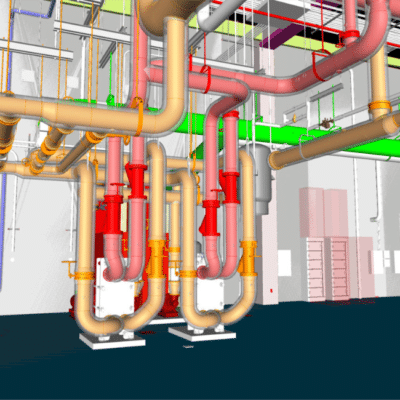Legacy Engineering software challenged
In the realm of industrial projects, engineering software such as Hexagon’s Smart Plant 3D, AVEVA’s AVEVA™ E3D Design, and Autodesk’s Plant 3D have traditionally dominated. These platforms, utilized by Engineering, Procurement, and Construction (EPC) firms, have set high standards in 3D modeling and project execution. However, Autodesk REVIT is emerging as a disruptive force, particularly in semiconductor fabs and light industrial projects, redefining industry norms with its Building Information Modeling (BIM) capabilities.

The Shift to Autodesk REVIT in Industrial Engineering
For decades, industrial engineering software has reigned supreme, catering to the intricate demands of large-scale projects with its sophisticated tools and specialized functionalities. EPC firms, well-versed in the intricacies of 3D modeling, have relied on these platforms to conceptualize, design, and execute complex industrial facilities, setting the standard for efficiency and precision in the industry. Yet, as the digital landscape evolves and project requirements become more diverse and interconnected, the emergence of BIM as a holistic approach to project management and design has ushered in a new era of innovation and collaboration.
Why Autodesk REVIT is Gaining Popularity
Enter Autodesk REVIT, a disruptor in the realm of industrial projects, challenging the status quo. While traditional heavy industrial project’s software excels in specific domains, REVIT offers a unified platform that transcends disciplinary boundaries, fostering greater synergy and coordination among project teams. This integration is particularly advantageous in semi-conductor plants and light industrial projects, where the convergence of multiple systems and workflows demands a cohesive approach to design and construction. This is especially important when you have a fragmented ecosystem of participants, with an AE team, GC and Trade Contractors, been all different companies.
Operational and Strategic Benefits of REVIT
What sets REVIT apart is not just its feature set but its wide adoption with the contractor ecosystem involved in these projects, contractors that have their internal prefabrication and install processes set up around REVIT. This shift reflects REVIT’s adaptability to the collaborative workflows prevalent in the construction phase, as well as its alignment with the evolving needs of project owners who prioritize interoperability, transparency, and long-term value.
Moreover, the growing mandate for Autodesk software, including REVIT, as a deliverable from project owners further reinforces its prominence in the market. As owners seek greater visibility and control over their assets, the use of REVIT becomes not just a preference but a requirement for contractors looking to secure and execute projects successfully. This trend underscores REVIT’s status as a standard bearer for efficiency, collaboration, and innovation in these industrial projects.
Expertise and Experience with REVIT
Additionally, the surge in REVIT usage can be attributed to the availability of qualified REVIT specialists compared to those specializing in Engineering Plant design software. With the massive amount of 3D modeling required by these plants, especially with the onshoring of manufacturing, the latter would never be sufficient. At ENG, our specialists excel in LOD 400 REVIT modeling, crucial for coordination and prefabrication tasks in sectors such as Semi-Conductor Fabs, Pharmaceuticals, Electric Cars, and Battery manufacturing.
Conclusion: The Future of Autodesk REVIT in Industrial Design
The increasing use of Autodesk REVIT in semiconductor fabs and other industrial projects signifies a shift away from older engineering software paradigms. . As EPC firms and contractors alike embrace REVIT’s holistic approach to project management and design, the industry is witnessing a paradigm shift towards greater collaboration, efficiency, and innovation. In this evolving landscape, REVIT’s prominence is not just a trend but a testament to its transformative potential in shaping the future of engineering design and construction.




